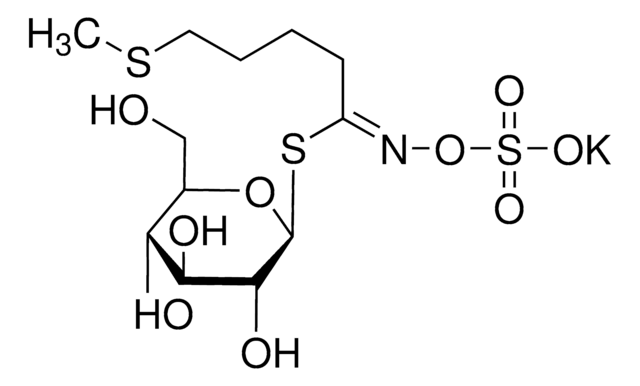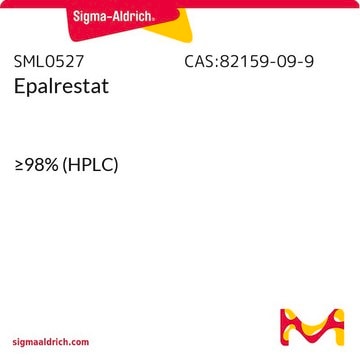S4441
D,L-Sulforaphane
≥90% (HPLC), liquid, phase II detoxification enzymes inducer
Sinonimo/i:
1-Isothiocyanato-4-(methylsulfinyl)-butane
Scegli un formato
Scegli un formato
About This Item
Prodotti consigliati
Nome del prodotto
DL-Sulforaphane, ≥90% (HPLC), synthetic, liquid
Origine biologica
synthetic
Saggio
≥90% (HPLC)
Stato
liquid
Solubilità
DMSO: soluble 40 mg/mL
H2O: insoluble
Compatibilità
for use with ABI 7500
Condizioni di spedizione
dry ice
Temperatura di conservazione
−20°C
Stringa SMILE
CS(=O)CCCCN=C=S
InChI
1S/C6H11NOS2/c1-10(8)5-3-2-4-7-6-9/h2-5H2,1H3
SUVMJBTUFCVSAD-UHFFFAOYSA-N
Applicazioni
Azioni biochim/fisiol
Codice della classe di stoccaggio
10 - Combustible liquids
Classe di pericolosità dell'acqua (WGK)
WGK 3
Dispositivi di protezione individuale
Eyeshields, Gloves, multi-purpose combination respirator cartridge (US)
Scegli una delle versioni più recenti:
Certificati d'analisi (COA)
Non trovi la versione di tuo interesse?
Se hai bisogno di una versione specifica, puoi cercare il certificato tramite il numero di lotto.
Possiedi già questo prodotto?
I documenti relativi ai prodotti acquistati recentemente sono disponibili nell’Archivio dei documenti.
I clienti hanno visto anche
Articoli
DISCOVER Bioactive Small Molecules for Nitric Oxide & Cell Stress Research
Filtri attivi
Il team dei nostri ricercatori vanta grande esperienza in tutte le aree della ricerca quali Life Science, scienza dei materiali, sintesi chimica, cromatografia, discipline analitiche, ecc..
Contatta l'Assistenza Tecnica.











